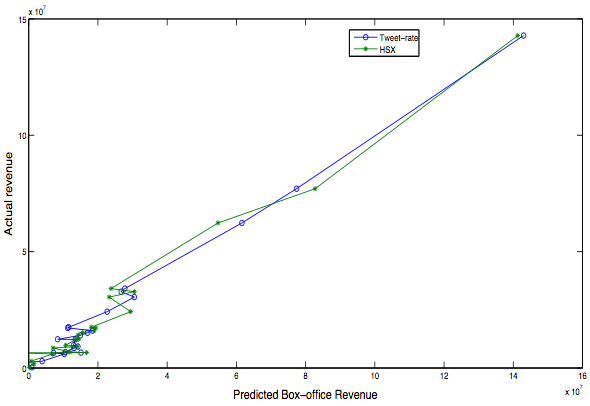A recent study [pdf] by Sitaram Asur and Bernardo A. Huberman at HP Labs found that it’s possible to use Twitter chatter to predict first-weekend box office revenues simply based on volume of tweets. The predictions were even more accurate when they introduced sentiment analysis (i.e. classified tweets as positive or negative).
The above chart shows predicted revenue on the first weekend versus actual. The blue line is the tweet predictor, and the green line is predictions from Hollywood Stock Exchange, a site where people can put down fake money in predicting box office revenues.
What you see are predictions that are more or less within in couple hundred thousand of the actual openings.
Ok, so what?
Asur and Huberman note that their tweet-based model outperformed HSX, which is interesting because HSX is switching to real money soon. That’s like having a slight edge over the dealer in black jack.
This also has implications in predicting other stuff that involves the opinion of the masses, for example, who is going to win an election or how well a product will sell. With that type of information, candidates could design their campaign strategies, and manufacturers could prevent over-production.
Music to Twitter’s ears, I am sure.
It’s no wonder companies are so hungry to find out what people are talking about on Twitter. Put together a high-quality analysis and visualization package or application and you’ll be rolling in it.
[The Technium via kottke]


 Visualize This: The FlowingData Guide to Design, Visualization, and Statistics (2nd Edition)
Visualize This: The FlowingData Guide to Design, Visualization, and Statistics (2nd Edition)

Pingback: Twitter predicts the future? | Hunter Scott
This doesn’t necessarily extend to other public opinions. It’s probably reasonable that people on twitter are a good representation of the people who go to movies on opening weekends, but I doubt twitter is a reasonable sample of people voting in general elections.
Also, the plot compares two predictions. It doesn’t compare predictions to actual openings.
yeah, for sure. twitter is making its way up to that point though.
as for the graph, the x-axis is prediction and the y-axis is actual.
Right, and even for people who are movie goers I would like to doubt. Tweeters are an excellent sample of self-selection. But for opinion polling or commercial market research we need unbaised samples to make predictions.
On the other hand, as tweeting is in its early years of diffusions and thus its users are currently a very special kind of communicators (age, income, location,life style, …) , it would be interesting to try they are representative for something because they are so unrepresentative for the population.
Is it just me or is the visualization kinda awful? How about log-log, an identity line, taking out the lines unless they mean something, and showing some metric like R^2 or MSE? … conference paper w/ matlab figures ftl.
Not just you. Such is life with graphs in research papers, I guess. Still an interesting read though.
Pingback: ソーシャルメディアを使った予想 » 経済学101
Hmm, looks like we’ve got three data points where both systems were pretty accurate…. and a whole buncha data points where it’s pretty tough to say WHAT’s going on….
Pingback: Coté's People Over Process » Links for April 12th through April 14th
Not very compelling IMO. They are both basically popularity indexes that move almost cyclically. The arbitrage is almost negligible. When HSX move to real money I suspect the perceived Twit-vantage will disappear.
Pingback: Agathe Battestini: Accent français » Blog Archive » Is Twitter predicting or making the future?
Pingback: Twitterは、とんでもない研究に用いられています。 | WEB DREAM
Pingback: Clairvoyance, meet Consensus | Solomon Giles Design